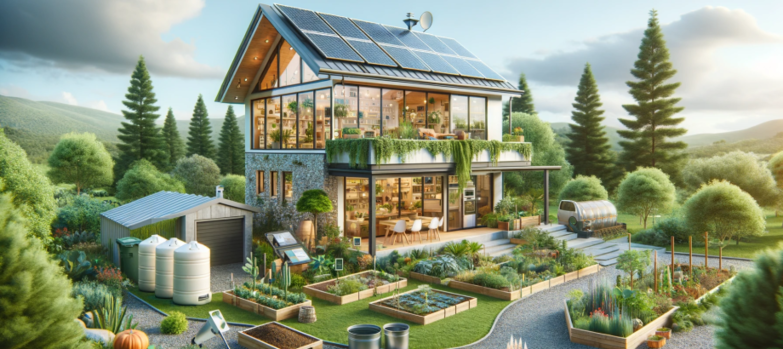What Makes Home Eco-Friendly: Definition

An eco-friendly home, also known as a green or sustainable home, is defined as a residence that is designed, built, or modified to reduce its environmental impact.
This is achieved through efficient use of energy, water, and other resources, while minimizing waste, pollution, and harm to the environment.
Key features include:
- energy-efficient appliances,
- use of renewable energy sources like solar panels,
- sustainable building materials,
- effective insulation,
- water-saving fixtures,
- designs that maximize natural light and improve air quality.
From energy efficiency to smart home technology, there are many factors that contribute to an eco-friendly living space. By following guidelines from this article, you can reduce your carbon footprint, conserve resources, and create a healthier environment for you and your loved ones.
So, get ready to transform your home into an eco-friendly oasis that not only benefits the planet but also enhances your quality of life. Let’s dive in and discover what it takes to make your home truly eco-friendly!
15 Traits Contributing to Eco-friendly Home
- Solar Panels: Utilization of solar energy for electricity and heating.
- Energy-Efficient Appliances: Appliances that consume less energy, such as those rated by Energy Star.
- Sustainable Building Materials: Use of recycled, renewable, or sustainably sourced materials in construction.
- Green Roofing: Roofing designed for energy conservation or covered with vegetation.
- Rainwater Harvesting Systems: Collection and use of rainwater for various household needs.
- Low-Flow Water Fixtures: Faucets, showers, and toilets designed to reduce water usage.
- Natural Insulation: Using eco-friendly materials for insulation to improve energy efficiency.
- LED Lighting: Energy-efficient LED bulbs for reducing electricity consumption.
- Smart Home Technology: Automation systems for efficient energy management.
- Passive Solar Design: Architectural design that maximizes natural heating and lighting from the sun.
- Geothermal Heating and Cooling: Utilizing the earth’s temperature for heating and cooling the home.
- Eco-Friendly Paint: Use of paints with low or zero volatile organic compounds (VOCs) to improve indoor air quality.
- Xeriscaping: Landscaping with drought-resistant plants to minimize water use.
- Double or Triple Glazed Windows: Enhanced windows for better insulation and energy efficiency.
- Composting Systems: Facilities for composting organic waste to reduce landfill contribution and generate natural fertilizer.
Eco Friendly Cabinet Painters in Houston →
Energy Efficiency
You should always prioritize energy efficiency when making your home eco-friendly.
One way to achieve this is by using energy efficient appliances. These appliances are designed to consume less energy while still providing the same level of functionality.
Another important aspect is passive solar design, which maximizes natural sunlight to heat and cool your home, reducing the need for artificial heating and cooling systems.
Insulation techniques are also crucial in maintaining energy efficiency, as they prevent heat loss during winter and heat gain during summer.
Efficient lighting solutions, such as LED bulbs, can significantly reduce energy consumption.
Lastly, integrating renewable energy sources like solar panels or wind turbines can further enhance your home’s energy efficiency by generating clean and sustainable power.
Sustainable Materials
To further enhance the energy efficiency of your home, consider using sustainable materials. Sustainable materials not only have a lower impact on the environment, but they also contribute to a healthier living space.
One option is to use recycled products, such as recycled glass, metal, or plastic, which reduce the demand for new raw materials and divert waste from landfills.
Another choice is to incorporate organic textiles made from natural fibers like cotton, hemp, or bamboo, which are grown without the use of harmful pesticides or synthetic fertilizers.
Additionally, green building practices and eco-friendly furniture can be implemented to ensure that your home is constructed and furnished with materials that are environmentally responsible.
Water Conservation
Implementing water conservation measures is essential for creating an eco-friendly home. By incorporating the following practices, you can significantly reduce your water consumption and contribute to a more sustainable future:
- Rainwater harvesting: Collecting rainwater in tanks or barrels can be used for gardening and other non-potable purposes, reducing the need for tap water.
- Drought tolerant landscaping: Choosing plants that require less water and implementing efficient irrigation systems can minimize water usage outdoors.
- Greywater recycling: Treating and reusing greywater from sinks, showers, and laundry can provide an additional water source for toilets and irrigation.
- Installing low flow fixtures such as showerheads and faucets can significantly decrease water usage without compromising functionality.
- Opting for water-efficient appliances like dishwashers and washing machines can save gallons of water with each use.
Waste Reduction
Minimize waste in your home by adopting sustainable practices.
Start by implementing composting techniques to reduce food waste and create nutrient-rich soil for your garden. Set up a designated area in your backyard for composting, or use a compost bin or worm farm if space is limited.
Additionally, participate in recycling initiatives by sorting your waste properly and disposing of it in recycling bins. Opt for products with minimal packaging to reduce the amount of waste generated.
Consider upcycling projects to give new life to old items and reduce the need for new purchases.
Lastly, embrace sustainable gardening practices by using organic fertilizers, conserving water, and planting native species to promote biodiversity.
Indoor Air Quality
You can easily improve the indoor air quality of your home by regularly cleaning and maintaining your HVAC system. This will help to remove dust, dirt, and other pollutants that can accumulate in your system and circulate throughout your home.
In addition to proper HVAC maintenance, there are several other steps you can take to improve the air quality in your home:
- Use air purifiers to filter out airborne contaminants and improve the overall air quality.
- Install ventilation systems to bring in fresh air from outside and remove stale air from inside.
- Opt for green cleaning products that are non-toxic and environmentally friendly.
- Choose furniture and materials that are made from natural and non-toxic materials.
- Maximize natural light in your home to reduce the need for artificial lighting.
Renewable Energy Sources
To further improve your home’s eco-friendliness, consider incorporating renewable energy sources. By harnessing the power of solar power, wind energy, geothermal heating, hydroelectric power, and biomass energy, you can significantly reduce your carbon footprint and dependence on fossil fuels. Renewable energy sources provide a sustainable and clean alternative to traditional energy sources, making them an ideal choice for environmentally conscious homeowners.
| Renewable Energy Source | Benefits |
|---|---|
| Solar Power | Generates electricity using sunlight, reducing reliance on non-renewable resources. |
| Wind Energy | Harnesses the power of wind to generate electricity, producing zero emissions. |
| Geothermal Heating | Utilizes the earth’s natural heat to warm your home, reducing the need for fossil fuel-based heating systems. |
| Hydroelectric Power | Converts the energy of flowing or falling water into electricity, producing clean energy without greenhouse gas emissions. |
| Biomass Energy | Uses organic materials like wood chips or agricultural waste to produce heat or electricity, reducing waste and carbon emissions. |
Incorporating these renewable energy sources into your home can not only help protect the environment but also save you money in the long run by reducing your energy bills.
Smart Home Technology
By integrating smart home technology, homeowners can further enhance their eco-friendliness by optimizing energy usage and reducing wastage. Smart home technology offers a range of features that promote sustainability and efficiency. Here are some ways in which it can contribute to an eco-friendly home:
- Home automation: Smart devices allow you to control various aspects of your home, such as lighting and heating, remotely or through voice commands. This helps you minimize energy consumption by ensuring that appliances are only used when needed.
- Energy monitoring: Smart meters and energy monitoring systems provide real-time data on your energy usage, allowing you to identify areas where you can make adjustments and save energy.
- Security systems: Smart home security systems not only protect your home but also offer energy-saving features like motion sensors that activate lights only when necessary.
Frequently Asked Questions
How Can I Incorporate Eco-Friendly Practices Into My Daily Routine to Reduce Energy Consumption at Home?
You can reduce energy consumption at home by using energy efficient appliances, smart home technology, and renewable energy options. Improve insulation techniques and opt for energy-saving lighting options to make your home more eco-friendly.
What Are Some Examples of Sustainable Materials That Can Be Used for Home Construction or Renovation?
When building or renovating your home, consider sustainable flooring options like bamboo or cork, energy efficient appliances, eco-friendly insulation made from recycled materials, and even green roof options for added sustainability.
Are There Any Simple Tips or Tricks for Conserving Water at Home Without Making Major Changes to My Plumbing System?
You can conserve water at home without major plumbing changes by using plumbing-friendly conservation methods. Simple water-saving hacks like installing low-flow fixtures, fixing leaks, and collecting rainwater can help you efficiently use water.
What Are Some Innovative Ways to Reduce Waste and Promote Recycling in a Home Setting?
To reduce waste and promote recycling at home, you can try innovative methods like composting solutions, upcycling ideas, and using sustainable packaging alternatives. These eco-friendly practices can make a big difference in protecting the environment.
How Can I Improve the Indoor Air Quality of My Home to Create a Healthier Living Environment for My Family?
To create a healthier living environment for your family, improve ventilation by opening windows and using fans. Use natural cleaning products to minimize indoor pollutants. Consider utilizing air purifiers and embrace green living practices.
How to Make Home Eco-Friendly
- Prioritize energy efficiency in your home
- Use sustainable materials
- Implement water conservation measures
- Minimize waste through sustainable practices
